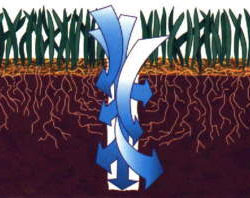A deep and healthy root system on greens isn't an accident. Many management practices are implemented to maximize root growth. One of the most important of these practices is occurring this week... the practice of solid-tine Aeration."


Solid-tine aeration pokes a long, solid spikeinto the putting surface. Although millions of holes are being punched, we are only affecting 3.5% of the putting surface. Each hole relieves compaction and creates a channel for fresh air and water to enter. A layer of sand on the putting surface is brushed until each channel is filled. Sometimes the sand bridges within the hole and doesn't allow for a complete filling of sand. This can be very beneficial. The pocket of air remaining in the bottom portion of the channel becomes a perfect environment for new root development. When new root growth reaches these open channels, the roots fill the voids and can extend down 10+ inches. We witness this benefit during our normal cup changing practices. Upon removing the 6" deep plug from the new pin location, roots will be hanging out several inches of a deep-tine channel.
Some other factors that promote a deep, expansive root system include:
Some other factors that promote a deep, expansive root system include:
- Proper water management. Over watering encourages short, lazy roots. Allowing the soil profile to remain on the drier side, encourages deep, aggressive roots.
Proper fertilization will promote root growth during ideal temperatures. Improper fertilization causes the turf leaves to grow at an accelerated rate at the expense of the root system. So, 'just fertilizing' isn't always the best thing.Maximizing photosynthetic capabilities by not mowing the turf too short, too soon. Think of the grass blades as little solar panels. The larger the panel, the more energy (food) can be created and stored.- Continued soil aeration by venting the putting surfaces with needle tines.
The speed of recovery from solid-tine aeration will be directly influenced by the weather. In a normal year, the putting surfaces will be 95% healed in 7-10 days. If night time temperatures continue to remain cold, the frosty mornings could slow the growth rate of the grass. Besides growing over the solid-tine hole, the turf must also grow through the 20 tons of sand that has been applied to the surfaces. The greens maintenance will be alternated with rolling and mowing to reduce the mechanical damage from the mowers. Once healed, we'll begin slowly reducing mowing heights and preparing for summer playing conditions, set to develop a deep and healthy root system.
Mike O'Neill
GCS
No comments:
Post a Comment